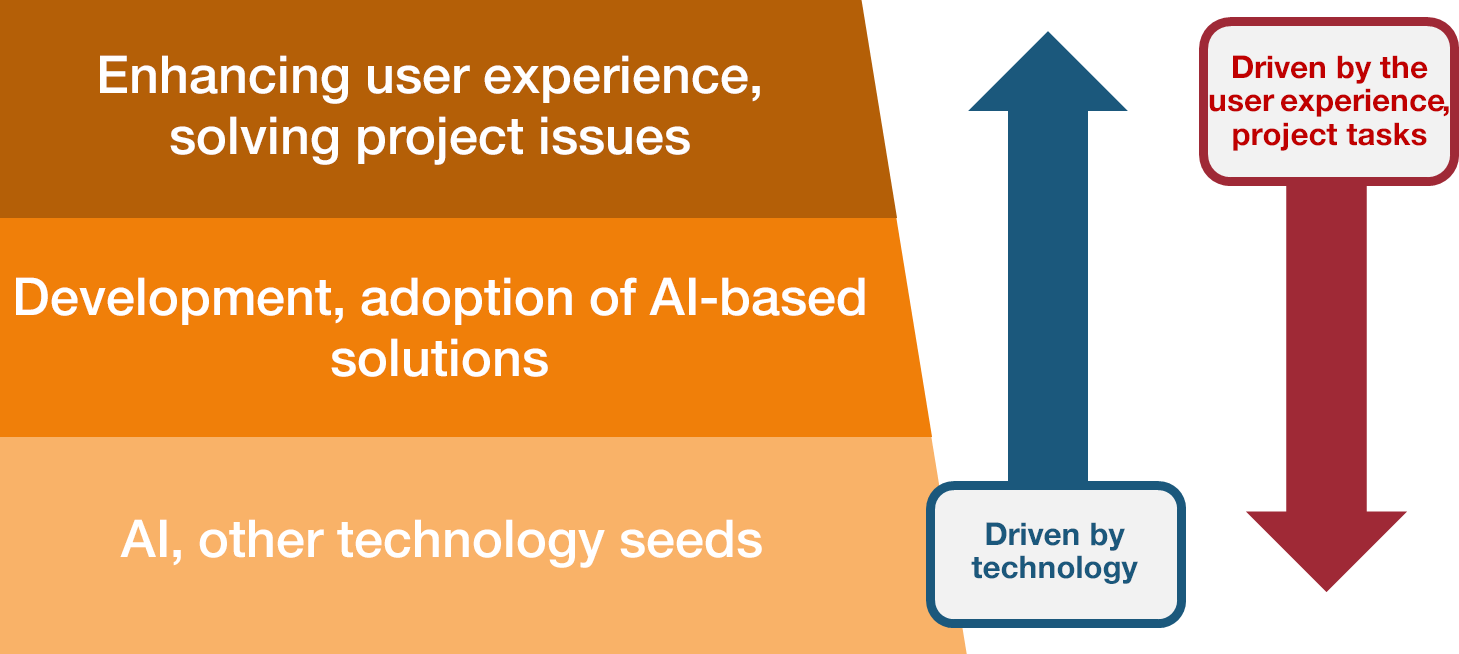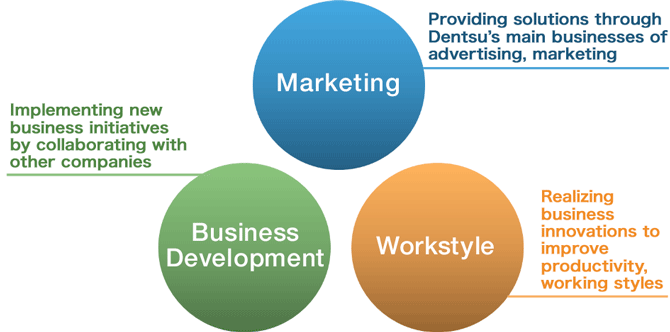“I wish this assignment could be handled by AI,” are words that I am hearing increasingly often coming from people grumbling about their work. But this is understandable, given that the third wave of artificial intelligence (AI) began early in the 2010s.
In the intervening years, the tide has changed; we have moved from being amazed at what AI can do to being interested in how to use it in business settings. Practical applications of AI in business are all about converting ideas, which is not how IT systems developed in the past.
In this article, I discuss how, through development projects, Dentsu sees and applies artificial intelligence as the computer system spreads throughout society.
I will also talk about AI Mirai—mirai being the Japanese word for future—a project team formed at the Dentsu Head Office in 2017, and the future outlook for applying AI in business.
AI Mirai project team
I work as a manager at AI Mirai, a project team that, formed to drive the use of AI inside and outside Dentsu as well as to cope with the changing AI environment, plays a key role in developing solutions and innovative technologies for marketing.

Briefly, the team focuses on the three main areas of marketing, business development, and working styles in order to offer practical AI applications to clients and the public at large.
The 40 members of our team are not merely technicians; they boast experience in areas of expertise covering everything from the main specialties handled by advertising companies—digital advertising, marketing, mass communications, and creative work—to working style reform management, and human resources.
While collaborating with partners, each team member considers how to apply AI to their specialty, envisions the potential and limits of applications, and contributes to building up our collective stock of business-related practical knowledge concerning the application of AI.
Ideas, flexibility key to applying AI in business
Business settings started using the Internet in the latter half of the 1990s, and cloud computing and big data in the 2000s. If we compare those developments with the current environment surrounding AI, we see two big differences.
First there is the popularity of the open source model.
Today, algorithms and solutions related to AI and machine learning are not limited to systems developed by major companies. It is not only IBM’s Watson or Microsoft’s Azure that are available; various user-friendly, open source and application program interface (API) formats are publically available.
Moreover, technological hurdles have been lowered considerably. This has been achieved by machine-learning frameworks, such as Chainer, TensorFlow, and Keras, as well as by high-quality datasets, such as WordNet, ImageNet, and Wikipedia.
By effectively combining such tools as a mash-up, companies and other users can, even without special technical knowledge, begin developing solutions more quickly than they can develop conventional IT systems.
Thus, instead of technically driven ideas about how to apply technological seeds in business, we now need ideas driven by project tasks and user experiences.
The starting point for developing ideas today is considering the best ways to combine technologies to successfully complete project tasks, and how user experiences can be enhanced.
Chart 1 Technically, User-driven Development

The second difference evident from comparing the development of the Internet, cloud computing, and big data with the current environment surrounding AI is the element of unpredictability so characteristic of artificial intelligence.
Systems that use AI are generally unable to initially predict results or return on investment (ROI). Even if they learn from relevant data, the systems cannot be relied on to produce the desired level of accuracy.
This means that development cannot go forward even after data and ROI have been fixed in advance. Instead, it is necessary to clearly distinguish between failure and success, broadly carry out development, flexibly apply proof of concept, and conduct feasibility studies.
I thus believe that the approach to developing and using AI differs from that used to develop conventional IT systems in two major ways. For AI:
- Ideas are conceived from user experiences and project issues in addition to technologically related knowledge
- Speed and flexibility are applied when trying out various developments amid uncertainty
Chart 2 Use of AI versus Standard IT System Development

The development and use of AI has more in common with conducting marketing campaigns than developing conventional IT systems. AI involves solving issues quickly with a wide range of ideas based on an accurate grasp of insights derived from user experiences and project tasks. Only then are marketing ideas needed to make practical use of AI.
Dentsu can therefore be more flexible in designing and offering practical AI applications by building on the practical knowledge acquired through AI Mirai, as well as from consumer understanding and clients’ challenges.
Chart 3 AI Mirai’s three main areas of focus

1. Marketing
AI Mirai is developing solutions in advertising and marketing, Dentsu’s main lines of business.
Included in these categories are our AI-enabled copywriting system, AICO, and our AI-based television rating prediction system called SHAREST.
We are exploring even more AI applications from a broad perspective, especially in the area of digital mass media creation, in which Dentsu excels.
At the same time, by drawing on the know-how and professional networks our team has established thus far, we are making every effort to apply our AI developments to help clients deal with challenges through use of the following.
- AICO: AI-enabled copywriting system
- SHAREST: AI-based system to predict television ratings
- An AI-powered commercial planner
- Algorithms for predicting future trends
- Development of advanced news analysis tools
2. Business development
While proactively collaborating with other companies, we aim to create new businesses beyond the sphere of marketing.
AI Mirai has formed a partnership with Nippon Cultural Broadcasting Inc., and is working to develop businesses that combine AI with the data and assets of various companies to develop two key technologies:
- AI speaker capabilities
- Audible device applications
3. Working styles
AI Mirai aims to implement business innovations while changing styles of working and boosting productivity for clients. By incorporating AI in robotics process automation (RPA) and standardizing atypical data, we can provide onsite support and add value to operations in order to bring innovation to businesses.
Not only are business innovations implemented at Dentsu but, as a result, the Company uses the resultant know-how to solve client issues by:
- Shifting regular operations to AI and advanced RPA
- Using algorithms to automatically classify work data
- Applying AI to website crawling
In the above three areas, AI Mirai has handled a combined total of more than 25 development projects, and has been expanding its expertise and professional network by applying AI to business settings.
Clients have asked us how AI can help solve specific problems, and one client even told us that, despite having installed an AI system, they could not find a way to enhance user experiences. Another client explained that, although data was available, they did not know how to apply it to business through the use of AI. These are just a few examples of the wide array of issues we can handle through the framework we have set up.
In the above paragraphs, I have probably gone overboard in promoting our activities. For this I apologize.
The next installment in this series will provide readers with details of projects undertaken by the AI Mirai team, all members of which hope to continue helping open up new opportunities for AI.

Takuya Kodama
Chief Planner
Business Strategy Division
